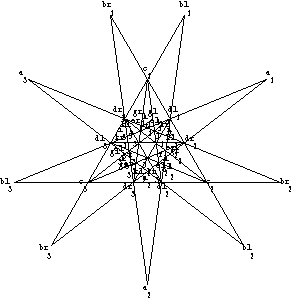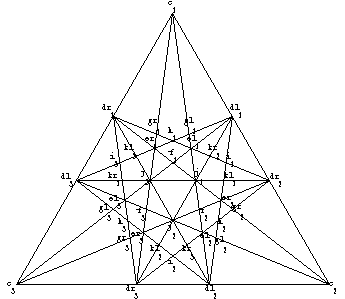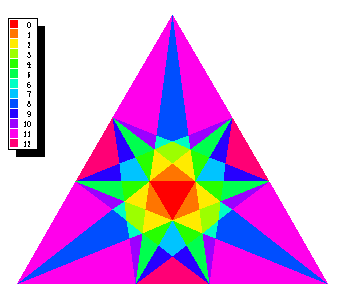
Icosahedra.m.
The subdivision of the plane of an icosahedral face by the intersections of all other planes (except the opposite plane, which is parallel to it) is shown below.
This graphic is the value of the variable lineGraphics from Icosahedra.m.
Show[ lineGraphics ];

The following graphic leaves out the outermost points and allows a better view into the crowded central triangle.
Show[ lineGraphicsInner ];

The lines so constructed divide the plane into fifteen different kinds of triangular or quadrilateral polygons, not counting the infinite exterior ones. The vertices of these polygons are the points a through k. Since the stellation should have icosahedral symmetry, the polygons in one plane that occur in this stellation must have threefold rotational symmetry. We combine sets of polygons with this symmetry into facets. The polygons in one facet are obtained from a single polygon by successive rotation by 120 degrees. Following Coxeter we number the facets 0 through 14. Number 0 is the innermost triangle. The other facets have either threefold rotational or sixfold dihedral symmetry and consist of three polygons each. The chiral facets, that is, those with only rotational symmetry, come in sets of two, one set being the mirror image of the other one. These two sets are labeled 2l and 2r, for example. In some stellations, the two related chiral facets occur together. Their union can be treated like a single facet with dihedral symmetry. It is, therefore, denoted by 2 and consists of all six polygons from 2l and 2r.
Here are facets 0 through 12. Not shown are the outer ones, No. 13 (consisting of the triangles bli dli ci and bri ci dri) and No.14 (consisting of the triangles ai dri+1 dli). By leaving out the large outer facets, we can show more details of the innermost facets. The graphic object is the value of the variable faceGraphicsInner. It uses the package Graphics`Legend` to produce the legend of color indices.
Show[ faceGraphicsInner ];

Up to The Stellated Icosahedra